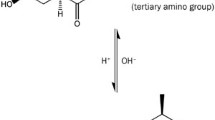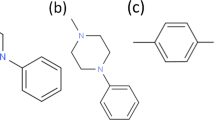Abstract
The objective of the study was to determine the region of maximum permeation of salmon calcitonin (sCT) through the gastrointestinal tract and to investigate the mechanism of permeation. For regional permeability determination, male Sprague-Dawley rats (250–300 g) were anesthetized and the gastrointestinal tissues were isolated. Stomach, duodenum, jejunum, ileum, or colon tissues were mounted on Navicyte side-by-side diffusion apparatus. Salmon calcitonin solutions (50 μM in phosphate-buffered saline, pH 7.4, 37°C) were added to the donor side, and the samples were removed from the receiver compartment and analyzed by competitive radioimmunoassay (RIA). For mechanistic studies, Caco-2 cells were grown on Transwell inserts (0.4-μm pore size, 0.33 cm2 area) in a humidified 37°C incubator (with 5% CO2). Transport experiments were conducted for sCT solutions (50 μM in Dulbecco's modified eagle's medium [DMEM], pH 7.4) from the apical-to-basolateral (A-to-B) direction and B-to-A direction at 37°C and from the A-to-B direction at 4°C. Cell monolayer integrity was monitored by mannitol permeability and transepithelial electrical resistance (TEER) measurements. The permeability coefficients (× 10−9, cm/sec) for sCT through rat stomach, duodenum, jejunum, ileum, and colon tissues were 0.482±0.086, 0.718±0.025, 0.830±0.053, 1.537±0.32, and 0.934±0.15, respectively. The region of maximum sCT permeability is ileum followed by colon, jejunum, duodenum, and stomach. The permeability coefficients (× 10−6, cm/sec) for sCT through Caco-2 cell monolayer were 8.57±2.34 (A-to-B, 37°C), 8.01±1.22 (A-to-B, 4°C), and 6.15±1.97 (B-to-A, 37°C). The mechanism of its permeation is passive diffusion through the mucosa as determined from the Caco-2 monolayer permeability of sCT.
Similar content being viewed by others
References
Keljo DJ, Hamilton JR. Quantitative determination of macromolecular transport rate across intestinal Peyer's patches.Am J Physiol. 1983;244:G637-G644.
Shah RB, Ahsan F, Khan MA. Oral delivery of proteins: Progress and prognostication.Crit Rev Ther Drug. 2002;19:135–169.
Meunier V, Bourrie M, Berger Y, Fabre G. The human intestinal epithelial cell line Caco-2, pharmacological and pharmacokinetic applications.Cell Biol Toxicol. 1995;11:187–194.
Asada H, Douen T, Waki M, et al. Absorption characteristics of chemically modified-insulin derivatives with various fatty acids in the small and large intestine.J Pharm Sci. 1995;84:682–687.
Sinko PJ, Smith CL, McWhorter LT, Stern W, Wagner E, Gilligan JP. Utility of pharmacodynamic measures for assessing the oral bioavailability of peptides. 1. Administration of recombinant salmon calcitonin in rats.J Pharm Sci. 1995;84:1374–1378.
Hastewell J, Lynch S, Williamson I, Fox R, Mackay M. Absorption of human calcitonin across the rat colon in vivo.Clin Sci. 1992;82:589–594.
Beglinger C, Born W, Muff R, et al. Intracolonic bioavailability of human calcitonin in man.Eur J Clin Pharmcol. 1992;43:527–531.
Antonin KH, Saano V, Bieck P, et al. Colonic absorption of human calcitonin in man.Clin Sci. 1992;83:627–631.
Kompella UB, Lee VHL. Delivery systems for penetration enhancement of peptide and protein drugs: Design considerations.Adv Drug Deliv Res. 2001;46:211–245.
Shah RB, Khan MA. Protection of salmon calcitonin breakdown with serine proteases by various ovomucoid species for oral drug delivery.J Pharm Sci. 2004;93:392–406.
Agarwal V, Nazzal S, Reddy IK, Khan MA. Transport studies of insulin across rat jejunum in the presence of chicken and duck ovomucoids.J Pharm Pharmacol. 2001;53:1131–1138.
Nishikawa T, Ishikawa H, Yamamoto S, Koshihara Y. A novel calcitonin receptor gene in human osteoclasts from normal bone marrow.FEBS lett. 1999;458:409–414.
Dong YL, Vegiraju S, Chauhan M, Yallampalli C. Expression of calcitonin gene-related peptide receptor components, calcitonin receptor-like receptor and receptor activity modifying protein 1, in the rat placenta during pregnancy and their cellular localization.Mol Hum Reprod. 2003;9:481–490.
Author information
Authors and Affiliations
Corresponding author
Additional information
Published: October 21, 2004.
Rights and permissions
About this article
Cite this article
Shah, R.B., Khan, M.A. Regional permeability of salmon calcitonin in isolated rat gastrointestinal tracts: Transport mechanism using Caco-2 cell monolayer. AAPS J 6, 34 (2004). https://doi.org/10.1208/aapsj060431
Received:
Accepted:
Published:
DOI: https://doi.org/10.1208/aapsj060431




